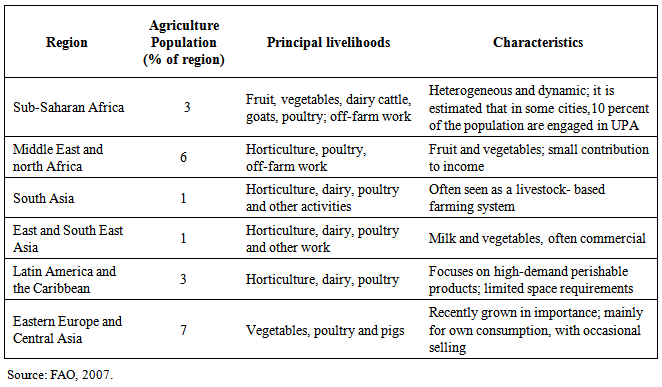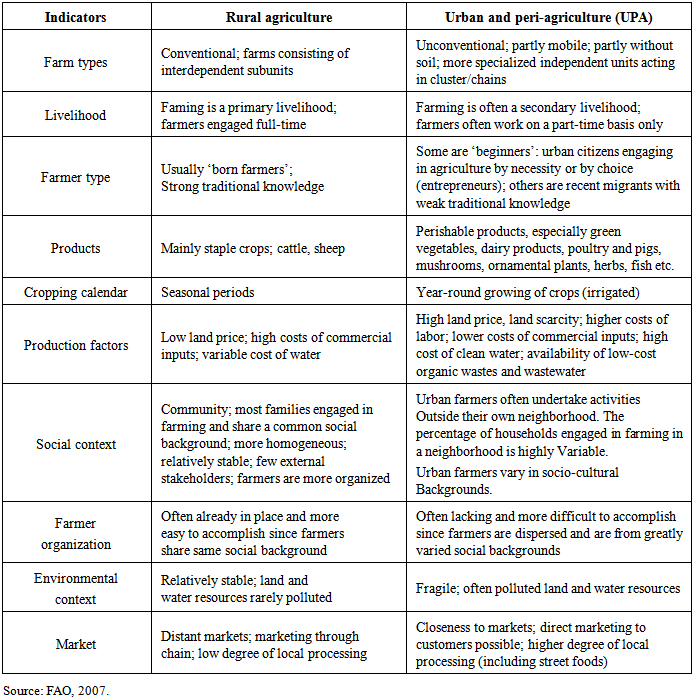-
Paper Information
- Next Paper
- Previous Paper
- Paper Submission
-
Journal Information
- About This Journal
- Editorial Board
- Current Issue
- Archive
- Author Guidelines
- Contact Us
International Journal of Agriculture and Forestry
p-ISSN: 2165-882X e-ISSN: 2165-8846
2014; 4(4): 275-285
doi:10.5923/j.ijaf.20140404.03
The Effect of Urban Agriculture in Urban Sustainable Development and Its Techniques: A Case Study in Iran
Mohammadi Jamal1, Soleimani Shiri Mortez2
1Associate Professor of Geography and Urban Planning, Faculty of Geography and Environmental Planning, Isfahan University, Iran
2Student of Geography and Urban Planning, Faculty of Geography and Environmental Planning, Isfahan University, Iran
Correspondence to: Mohammadi Jamal, Associate Professor of Geography and Urban Planning, Faculty of Geography and Environmental Planning, Isfahan University, Iran.
| Email: |  |
Copyright © 2014 Scientific & Academic Publishing. All Rights Reserved.
During the recent decades, the tendency to urbanization and better life has involved destructive impacts on environment on one hand and many pressures on nature to supply the necessities of urban life including food, energy, materials, and so forth on the other hand. The development of urbanization and its consequences are inevitable. As a strategy for reducing the pressure on nature and constructive interaction between cities and natural environment in such a way that some needs of citizens are met by themselves and within city, urban agriculture leads to improve and protect ecological structure of city, cultural reinforcement, social reconstruction, and economic growth in addition to providing sustainability and food security. The present study investigates the global experiences related to urban agriculture and presents some strategies to develop urban agriculture in order to achieve sustainable development in Iran with a focus on increasing trend of urban population and its resulted problems.
Keywords: Urban agriculture, Urban sustainable development, Food security, Environment
Cite this paper: Mohammadi Jamal, Soleimani Shiri Mortez, The Effect of Urban Agriculture in Urban Sustainable Development and Its Techniques: A Case Study in Iran, International Journal of Agriculture and Forestry, Vol. 4 No. 4, 2014, pp. 275-285. doi: 10.5923/j.ijaf.20140404.03.
Article Outline
1. Introduction
- Sustainable development needs to new technical solutions to guarantee efficient use of resources as well as decreasing population and damages. Certainly, good environmental policies can cause various economic and social benefits. In 2008, urban population exceeded 50 percent of the earth population and it is expected to reach 4/6 milliard people up to 2030 and with respect to this increasing population, a precise planning is needed in cities to create food security and provide enough food for the growing population (Aubry & Ramamonjisoa, 2012). While urbanization is usually considered as a demographic or economic phenomenon, it involves important ecological consequences as well. Importantly, from the perspective of ecosystems coherence, cities change natural cycles of valuable food and chemical resources significantly. Keeping people and livestock away from the land supplying their life avoids economic recycle of phosphor, nitrogen and other nutritive and organic materials as well as prevents their return to agricultural lands and forests (Dehghan, 2006). For urban residents, food is regarded as the most important need which has been separated from its main source, i.e. soil and sun. In the age in which human and earth are strange with each other, most of the city residents wish to return to nature and use its blessings. All over the world, there are many innovations to supply needs locally and create efficient systems of resources in cities. For example, recycling iron and aluminum decreases the need to extract new mineral stones. Accordingly, a question is raised indicating that “is is better to provide consuming foods of cities in the same regions?” The growth of urban agriculture in rich and poor cities of the world can be a good answer to this question. During the last decades, urbanization development in Iran and the need o create “sustainable cities” providing enough food services, primary shelter and good job for all urban residents is considered as a main challenge for the future of the country. To solve these problems in some of cities of the second world countries and even the first world, officials of cities and citizens have attempted to reconsider and use the existing space creatively as well as finding an answer to the question indicating that “how an empty space can be changed into a powerful space? Using space which are not used and empty pieces such as balconies, roofs and public gardens which are found in cities abundantly is regarded as a creative strategy to produce urban foods. It can also lead to food security and residents` employment. In Iran, therefore, urban agriculture, as a complementary strategy to decrease urban poverty and food insecurity as well as increasing urban environment management, can play a significant role to increase urban food security. Such category also is helpful to develop local economy, decrease poverty, encouraging poor citizens, especially women, to participate in social urban activities (Chen, 2012). With respect to above mentioned and the lack of such agriculture in Iran, it is supposed that urban agriculture can contribute to achieve all three dimensions of sustainable development such as economic, social and environmental aspects. Hence, the present study attempts to explore the literature of such agriculture around the world through descriptive-referential method and the strategies to develop this kind of agriculture in various cities of the country are presented with a focus on their economic, social and environmental conditions. Today, resources providing human food are threatened by various factors including the decrease of fertile lands at local scale, increasing dependency to fossil fuels to produce and transport foods at global sale, and so forth. Moreover, far distances of urban farms from cities leads to using transportation, cooling equipments, packaging, and consequently the loss of a great amount of fossil fuels and producing pollution and garbage. So, the more the distance between the place of production and consumption is, the fossil fuel consumption will be more and also, these energy resources will be ended more rapidly. On the other hand, high use of fossil fuels causes to emit more carbon dioxide in atmosphere leading to warming the earth atmosphere, climate changes, wide droughts, melting glaciers, and the earth instability. Further, cities consume 75% of the world`s resources and produce a large amount of garbage and damages in return (Dehghan, 2006). Cities development is responsible for 70% of carbon emission in the world (Chen, 2012). Also, food insecurity and the lack of economic access to foods and high quality foods are of increasing problems of cities. Approximately, 50% of foods are spoiled or destroyed during transportation (Smit, 2000). Most of fruits, vegetables and different products sold in markets are selected based on their resistance against industrial harvest equipments and the distance they travel but not for their taste, flavor or nutritive quality (FAO, 2007). Freeman introduced four motivation and important role of urban agriculture in developing world including hunger relief, completing the process of starch diet, family income improvement, and decrease of food costs in order to create the opportunity to purchase other goods (Dehghan, 2006). Environmentally, urban agriculture causes to reproduce soil by removing air pollution, providing space to compost organic garbage, closing energy rings and material stream. The importance of urban agriculture as a complementary strategy to achieve the objectives of new Millennium (eradicating poverty and hunger, promoting gender equality and enabling women, fighting against HIV-AIDS and other disease, and ensuring environmental sustainability) is significant. Urban agriculture as a permanent part of urban systems are considered as an important component of urban sustainable development due to many social, economic and environmental advantages and also is considered as a tool for urban residents to access to produce foods (Ghimire, 2008). With respect to the wide urbanization and urban problems formation (economic, social, ecologic, etc.) during the last years and the necessity of finding a solution to cope with the problems that decrease the problems on one hand and increase sustainability on the other hand, the idea of urban agriculture as a sustainable strategy can help urban management in social, economic and environmental areas. Considering the role of urban agriculture to control urban runoffs, food security, decrease the distance between the place of agricultural products production and consumption, decrease of fossil fuel consumption, compost organic garbage, closing energy rings and materials stream, reproducing oil and its importance to prevent creating urban heat island, emit carbon dioxide in atmosphere, water, air and soil pollution, climate changes, melting glaciers, wide droughts, the loss of life quality in residential regions, social isolation, crime, and the manifestation of the mentioned factors in most of Iran`s cities, the present study tends to present strategies to develop urban agriculture in cities by studying related global experiences. Literature review Urban agriculture may seem to be a new concept but it should be said that city and agriculture have an old relation with each other. There are a lot of evidences about agriculture in old cities such as Mexico, London, Paris, Rome, and Pekan (Dehghan, 2006). Further, the idea of garden on roof and cultivating on it was adopted by Iranian in 2500 years ago. The suspended gardens constructed by Babylonians (600 B.C) also were considered as an instance of urban agriculture. In Renaissance age, some gardens built on roofs were also created in France and Italy (Rezvanian, 2010). Wright and Le Corbusier were the naturalist pioneers and the persons who created agriculture on terraces and roofs in the twentieth century (Nahrli, 2011). Nowadays, considering the increase of urban population in the world and increasing food demand, countries and international associations consider urban agriculture as a strategy to cope with the crisis of food security and ecological sustainability of cities in order to prevent from food security crisis in cities as well as develop urban sustainable development. During the last decades, attention to urban agriculture has been rapidly increased both in international development agenda and national officials of cities and nongovernmental organizations to run projects. After the collapse of Soviet and eliminating agricultural contributions, the government of Cuba encouraged to plant vegetables in private gardens and public places of cities and replaced a chemical fertilizer-based herbal system with animal-based fertilizers. In 1997, the so called system could produce approximately 21000 tons vegetables and by achieving 27/2000 tons, it was changed into a successful pattern to fulfill similar projects around the world in 2005. In Havana (the capital of Cuba), more than 26000 people work on 2439 hectares and produce 25000 tons food per year (FAO, 2007). In Tanzania, Dar-al-Salam municipality supports urban agriculture at different levels and urban agriculture is recognized as one of the uses of urban land now (Aubry & Ramamonjisoa, 2012). An FAO-implemented study provides estimations per region of urban-based agriculture, as well as the population and main crop and livestock systems involved (Table 1).
|
2. Theoretical Framework and Findings
2.1. Urban Sustainable Development and Its Dimensions
- According to the definition provided by world commission on environment (1987), sustainable development is a development which can meet the present generation's needs without threatening abilities of the next generations (Harris, 2000). After presenting this definition, the provided concept has been widely used in different areas. One of the highly wide aspects of study regarding development is the notion of urban sustainable development proposed with the aim of solving urban problems (MoharamNejad, 2004). Urban sustainable development as a partial part of sustainable development is based on reasonable use of natural resources. Therefore, sustainable city is derived from a development process providing the supposition and possibility of permanent promotion of city’s and region's social-economic- ecological health. Hence, the following cases can be introduced as urban sustainable development strategies:● Minimizing environmental consequences● Minimizing non-renewable resources consumption● Exploiting renewable resources
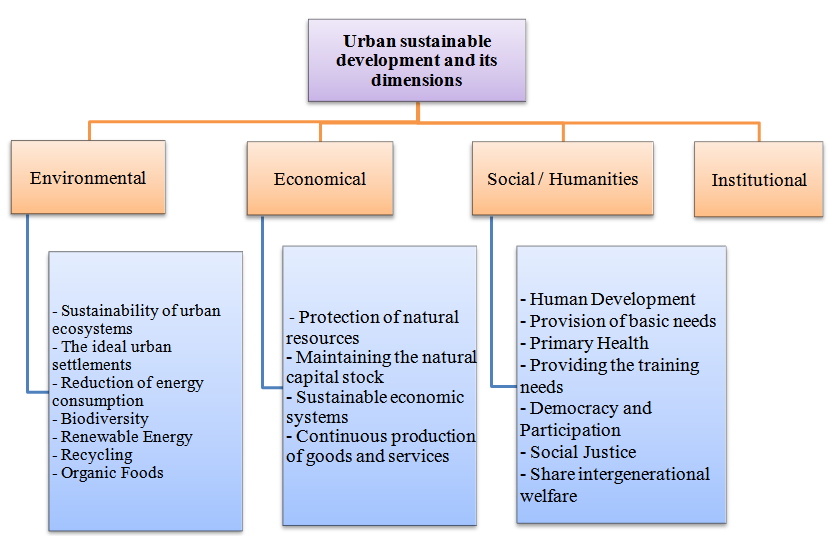 | Figure 1. Shows various aspects of urban sustainable development and its subsections |
2.2. Urban Agriculture and Its Different Types
- Urban agriculture can be defined as the growth of plants and breeding animals to provide food and other defined materials within and around cities and towns and its related activities such as production and delivering production factors, processing and marketing. Call this rebirth of locally based agriculture and food production “civic agriculture”, because these activities are tightly linked to a community's social and economic development. Products (chen, 2012). There are different definitions about urban agriculture and different people categorized this concept in different ways. The concept of urban agriculture refers to farming in urban environments. In this sense, foods are produced on roofs, yards, gardens, or in open public spaces and even in underground. In other words, urban agriculture follows two main objectives including people participation to increase food security and improve nutrition and decreasing environmental effects through agricultural development in urban boundaries (FAO, 1999).Urban agriculture can be defined as the growth of plants and breeding animals to provide food and other defined materials within and around cities and towns and its related activities such as production and delivering production factors, processing and marketing products (Thomas, 2012).Generally, agricultural activities in city can be categorized into two classes including urban and peri-urban agriculture (UPA). In urban agriculture, the agricultural practice is done inside city. Most of cities and towns have empty lands which can be used for urban agriculture such as places which are not suitable for construction (along rivers, in the vicinity of airports, and so forth) and useless public or private lands which can be used for urban agriculture temporarily. Different types of urban agriculture can be created including public gardens (official and non-official), garden houses, kindergartens, roof gardening, and cultivating in underground and stores (e.g. mushrooms, earthworm). Such agriculture is done at small scale although sometimes, mushroom, herbs and ornamental plants are also produced inside city. Peri-urban agriculture is done in suburb. Around urban regions, there are tendency to significant changes in certain time periods. The rush of people from both villages and cities causes to increase population and land price. Such changes directly influence agricultural products production systems and consequently, agriculture becomes more compact at smaller scale and production tends to perishable products and animal production (meat, egg, milk). According to the experiences of various countries of the world such as Cuba, Vietnam, Lebanon, and Argentina, agricultural companies are mostly placed in suburb and their farms are bigger than the farms inside city and are greatly market-oriented. Roof gardening Roof gardening is the third type of agriculture inside city which is a certain type of urban agriculture. In roof gardening, building roofs are used to grow plants. There are two forms of gardening roofs including green roofs and rooftop gardens. Adding grass to roofs is a way for urban sustainability to solve some urban problems involving the concern about the lack of space for agricultural activities, food insecurity of citizens and urban environmental issues. Green roofs are innovative architectural and engineering projects which usually consist of a grass layer and smooth low-growing plant sand are built on roof which are constructing or on existing roofs. Using green roofs has many advantages including protecting and increasing roofs lifetime, decreasing required energy, decreasing greenhouse gases emission, increasing green space per capita, and decreasing runoffs. Also, green roofs decrease daily energy demand of a building for air conditioning during summer more than 75%. As Lioasserted, annual heat flow is decreased up to 30% through a building with green roof (FAO, 2007). In Iran, there are some examples of urban and suburban agriculture. However, the point is that this issue has not yet been considered as a strategy for urban and regional sustainable development; terraces of Shahrak Omid in Tehran and even fruitful trees and breeding some poultry in universities can be referred as the examples of urban agriculture which have been mostly created to make happiness and fill students free times but not to produce foods. Moreover, producing vegetables around big cities (e.g. Tehran) can be regarded as peri-urban agriculture. So, the use of unhealthy wastewaters by farmers and lack of enough supervision sometimes leads to the objection of consumers.
2.2.1. Characteristics of Urban Agriculture and Its Distinction with Rural Agriculture
- Some researchers have attempted to clarify the distinction between urban agriculture and rural agriculture. They use some criteria to make such distinction including proximity to downtown, administrative inclusion of urban borders and products type. Researchers and planners have gradually concluded that there is no clear border between urban and rural regions and with a deep look at these two concepts, it is found that both are physical and organizational concepts. Many researchers also indicated that urban agriculture is complementary of rural agriculture to a great extent and increases national food system through providing products which cannot be supplied by rural agriculture (for example, destroyable products). Further, urban agriculture can be a good replacement for foods import leading to make rural lands free for export goods production (the effect of urban agriculture in regional and national sustainable development). Nevertheless, there are ignorable structural differences between urban agriculture and rural agriculture (Table 2). The most important characteristic of urban agriculture making it distinctive from rural agriculture is its closeness with urban ecological and economic system. Such interaction includes using urban residents as workers, using urban public resources (e.g. organic garbage as fertilizers and urban wastewater for irrigation), direct communication with consumer, direct effects in urban environment (positive and negative), a part of urban foods system, competition for land with other urban functions influenced by urban policies and planning.
|
2.2.2. Actors and Places of Urban Agriculture
- Contrary to common supposition, poor people consist of a large number of urban agriculture. In many cities, most of low income people of society, low level and middle level officials, teachers, as well as richer people searching for a good investment approach to urban agriculture. Women form an important part of urban agriculture. However, women often face with more problems to access to cultural resources, services and/or constraints limiting their capabilities for more participation in suburban agriculture (FAO, 2007). Urban farmers can work individually or by family, officially or non-officially, in a group, cooperative or other agricultural organizations. As mentioned, urban agriculture may be done in inside cities or in suburban regions. These activities may also be done on plot (home, yard, kitchen, balcony, and roof) or on ground far away from residential place (out of city which agricultural tasks are combined with non-agricultural tasks, for example, home works and small businesses), in private lands (property or rental), in public lands (parks, protected regions, along roads, rivers and railways), or in semipublic lands (schools and hospitals).
2.2.3. Products of Urban Agriculture
- Various social, economic and physical decision makers determine that what products should be produced and how they should be produced. In most cities, dominant products production in urban agricultural section is the result of certain food diet and food consumption pattern of city and suburb which is influenced by culture, climate, soil conditions, social, and economic conditions. In addition to the above mentioned, climate also influences breeding urban animals. Foods production may include various products (fruits, mushrooms, vegetables, etc.) or animals (hen, rabbit, sheep, cow, pig, fish, bees, etc.), or a combination of them. Often, destroyable and valuable vegetables and animal products and animal products are produced. Nonfood products include medicinal and aromatic plants, ornamental plants, tree (seed, wood, fuel, etc.) and tree seedling. Wagner et al (2002) introduced three main production systems (Thomas, 2012):● Professional production systems, special for producing and breeding a certain type of product or animal: rice, vegetables, fruit, fish, hen;● Mixed production systems as the combination of two activities (two main part of products or a combination of animal and product)● Compound production systems with more than two main activity (products and/or animals compound)Generally, it can be claimed that plants and dairy products which are almost destroyable and the possibility of their decay is high during transportation are more considered in urban agriculture.
2.2.4. Economic Activities of Urban Agriculture
- Urban agriculture involves the activities of producing agricultural productions as well as processing, retrieving and recycling (e.g. compost). In this kind of agriculture, production and marketing are done more rapidly compared to rural agriculture due to geographical nearness to resources.
2.2.5. Destination of Productions and Orientation of Market
- In many developing countries, an important part of urban agricultural production is bargaining for its consumption and it surplus. However, the importance of urban agricultural market should not be underestimated either in volume or in economic value. Products are sold at production place or at local stores (supermarkets) or at local markets (farmers) but a part of products are processed and sold at street for its own use and/or they are processed, packaged and provided by one of the aforementioned ways.
2.2.6. Production Scale and Used Technology
- In city, there may be personal or family farms (within yards and roofs), group or cooperative farms and commercial companies at different scales such as small or medium farms and some large farms. The main point is that its considered objective is not farming in its general sense but the purpose of creating urban agriculture (farming in city) is to plant and produce micro food products through easy techniques and with the minimum facilities. Accordingly, urban agriculture can be classified into the three following groups (Daneshpour, 2008):● Farming in the lands around rivers such as yards, balconies and roofs● Farming in the lands shared by many citizens in cities and/or in shared roofs● Farming in commercial lands existing in city The technology used by urban agriculture in developing countries is at a relatively low level. Nevertheless, the tendency to advanced technical agriculture and its different instances can be seen in some cities.
2.2.7. Challenges and Negative Points for Urban Agriculture
- According to a critical view, urban agriculture causes to create new challenges for sustainable development and cities management in addition to its benefits. The main concern pertains to health, environment, management, and economy of land use. Health dangers High pollution of urban regions involves the danger of polluting garden products and cultivated vegetables and husbandry leads to epidemic disease. Pesticides and animal wastes pollute soil and underground resources. The dangers related to urban farming health should be taken into serious consideration and in this case, it should be done in such a way that such attention is not led to exaggerated reactions and the fear of foods contamination. On the other hand, the possibility of foods contamination should be avoided by preventive actions. Barley and Look classified the most important health dangers pertained to urban agriculture as follow (FAO, 2007):● Pollution of agricultural productions with pathogenic organisms resulted by irrigation with polluted waters flow and/or unhealthy touch of new products during transportation, processing and recycling● Human disease transmitted by disease carriers absorbed by agricultural activities (such as mosquito, plague, and disease producing ticks)● Pollution of products and/or drinking water by Agro-chemical wastes (chemical fertilizers, pesticides and fungicides)● Pollution of agricultural products by heavy metals of contaminated soil, air or waters resulted by transportation and heavy industries● Disease transmission form domestic animals to human (Zoonotic Disease)● work health dangers, for example, by touching Agro-chemical materials and untreated wastewater improperly to produce foods and food industryEnvironmental dangers Since a great number and non-standard amount of chemical fertilizers and pesticides are used in agriculture, local water resources may be polluted. Also, overuse of nitrate rich fertilizers of hen or pig can lead to underground waters pollution. Particularly, discharge of compact poultry farms wastes can pollutes drinking waters through transporting micro organism heavy loads to their sources. Additionally, inappropriate farming methods lead to decreasing vegetations and creating wetlands (Figure 2).Figure 2 shows the challenges facing urban agriculture. Studies show that water and soil pollution is a serious problem for urban farming in Iran because in most cities, urban waste water enters the surrounding land. Also Limitations of technology in Iran is an obstacle to the development of urban agriculture.
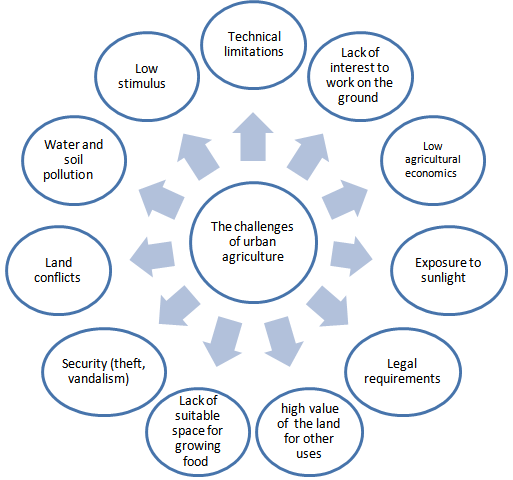 | Figure 2. The challenges of urban agriculture |
2.3. Urban Agriculture Strategies to Achieve Urban Sustainable Development in Iran
- A sustainable city let all its citizens to meet their needs and increase their welfare without damaging nature or threatening life condition of people at the present time or in future. Urban sustainable development needs to establish rotary or continuous and highly efficient systems in cities to make the best use of resources and surface. Such activity has is able to decrease the distance between the place of supplying resources and demand place. Sustainability creates the necessity of establishing the concept of neighborhood in order to increase the efficiency of urban consumption patterns. Accordingly, agriculture in city and around city can significantly contribute to decrease urban poverty and hunger as well as ensuring environmental sustainability. In overall, the strategies to achieve urban sustainability in Iran can be introduced as follow:
2.3.1. Food Security Strategy and Feeding City
- One of the most important advantages of urban agriculture is to create food security and produce healthy foods. The costs of producing and distributing foods from rural regions to urban regions and/or foods import for city is continuously increasing and it is expected that urban food insecurity is enhanced. Producing foods in city, often, is the result of reacting to insufficient and unreliable access to food and the lack of purchase power of the urban poor. On the other hand, urban agriculture improves both foods quantity (access to inexpensive protein resources) and quality. In addition to food security and feeding urban products producers, a high amount of foods is also produced for other populations. It is estimated that 200 million people of urban residents produces (FAO, 1999) up to 20% of urban markets food in the world (Ghimire, 2008). ● In Hanoi, 80% of fresh vegetables, 50% of pig, fish and hen meat as well as 40% of egg are supplied by urban and suburb agriculture.● In urban and suburb region of Shanghai, 60% of vegetables, 100% of milk, 90% of egg, and 50% of pig and hen meat are produced in city.● In Accra, 90% of fresh vegetable consumption is also from the production made in city. Even in Britain, 30000 urban regions have been specified to grow vegetable and fruit (Daneshpour, 2008). Considering the aforementioned, different climatic conditions of Iran, it can be concluded that each of cities are able to supply a part of their food needs in many cases. For example, Isfahan is a city appeared due to its susceptible soil and water resources and after many years, it is still in the same condition. The urban agriculture history in Isfahan dates back to the Safavids. During Safavids era, there have been gardens in two sides of Char Bagh Street which was used a recreational place and the garden doors were open for to use the garden products but the products were not allowed to take out of the garden (Sohrabi & Feizi, 2010). Culturally, due to appropriate natural bed for agriculture and Zayande Roud, the city has been in a close relation with nature. Therefore, it can be claimed that urban agriculture complements rural agriculture and increases food system efficiency.
2.3.2. Economic Strategies
- Since in under development countries like Iran, poor people spend a significant part of their income to buy foods (50-70%), foods production decreases family costs to purchase foods and causes to save money; transportation costs are also decreased. Moreover, the third world countries have the highest rate of immigration to urban regions, so urban agriculture can help these cities through enabling people economically. On one hand, economic benefit can be an appropriate motivation to begin and promote an activity. Classifying urban agriculture users leads to two groups; the first class includes people doing activity to meet their family needs and the second class involves people doing activity with business intention and gaining benefit. For the second class, there should be some facilities to provide their product leading to encourage the activity. As mentioned, in Cuba, after previous Soviet collapse, the government established some policies to support urban agriculture. As an example of supportive activities, it can be referred to establishing small markets across the city in which fresh agricultural products were merely supplied. Also, urban farming helps local economy`s development by developing small investments to produce necessary ingredients for farming (e.g. compost and earthworms), processing, marketing, and providing services such as animal health, transportation and self-employment across the community. In the early 1990s, in Nairobi, self-employment in agriculture had the highest income among small companies and was considered as the third income across all the cities of kenya (Ghimire, 2008). In addition to economic benefits for producers, urban agriculture can contribute to create new industries and job opportunities in cities and around them. These opportunities including providing and producing fertilizer, producing seed and tools, marketing and distributing, processing, agricultural cooperatives- consumer and agriculture work- cause to develop small dependent investments such as producing required factors for agriculture, packaging and marketing. Processing foods may involve making yogurt from milk, or frying peanut Hindi, hen, egg, etc.
2.3.3. Social Strategies
- Urban agriculture, in its stabilized form, can act as an important strategy to decrease or eliminate poverty. It cannot be successful but by a proper culture building. So, informing people from food values of fresh agricultural productions and the amount of difference between fresh and freeze products can be helpful to promote such activity among citizens. Additionally, some municipalities or non-governmental organizations, with the aim of supporting deprived groups such as orphans, disables, women, unemployed immigrants, or old people run urban farming projects. In most of advanced cities, urban agriculture is created for physical or mental health of people rather to produce foods. Further, urban and suburb farms may play an important role to provide recreational opportunities for citizens (recreational paths, purchasing foods and visiting facilities) and/or have educational functions (contacting with animals, training about environment and so forth). Urban and suburban farms may also play a significant role to provide recreational and educational activities for urban citizens and perspective management and society building. With respect to increasing trend of social crime, especially in big cities, urban farming can promote sustainable development by decreasing vulnerability of urban populations against ecological changes of the world. Performing the project of green roofs and gardening in downtowns have led to decreasing crimes. Young people are entertained by participating in these programs and find a feeling of self esteem and usefulness. Furthermore, managing a piece of land creates a sense of unity between people which can be followed by teamwork to solve important local problems.
2.3.4. Ecological Strategies
- Urban agriculture is a part of urban environment system and can play an important in urban environmental management system. Firstly, a developing city produces more organic wastes. For most of cities, removing garbage is a main problem. Urban agriculture can help city sole a part of its problems by changing urban trashes into a generator resource. However, our modern cities are generally built as giant machines that consume huge amount resources (input) and generate large amount of waste (output) (Figure. 3). On the contrary, a sustainable city is perceived to be able to keep the urban processes going with less amount of input of resources and less amount of waste production thanks to the recycling of key life-supporting materials within the city.
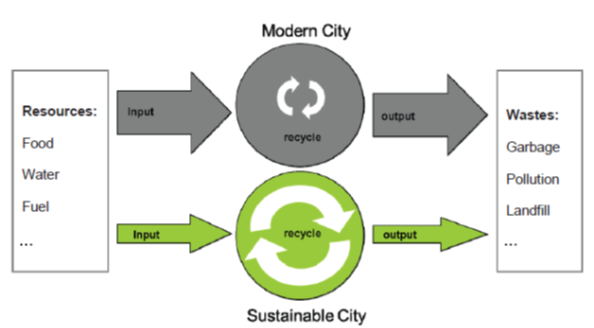 | Figure 3. Recycling of materials in an urban ecosystem reduces resources input and waste output. Modified from Turner (Chen, 2012) |
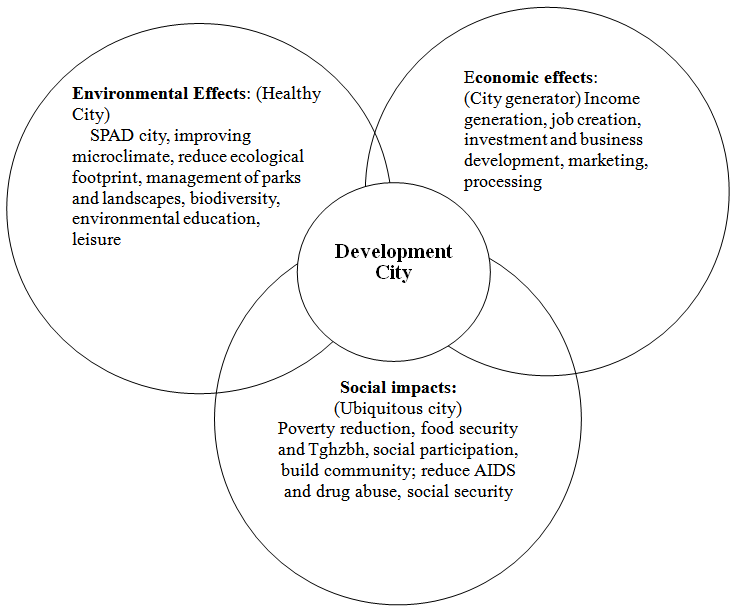 | Figure 3. Urban agriculture strategies to achieve urban sustainable development |
3. Conclusions
- In conclusion, considering the global experiences regarding urban agriculture, it can be stated that urban agriculture has a potential which can guarantee cities sustainability in Iran in three aspects. Firstly, it can produce income and dynamic economic system in city by creating job opportunities for residents of cities as well as absorbing and organizing capitals. Secondly, it can leads to food security for citizens and decreasing poverty, renewing civil community, and developing neighbors participation by producing foods inside and around cities. And finally, it can creates joyful perspectives for spending leisure time, education and research by increasing the level of greenness and improving park management and biological diversity. Increasing the level of urban greenness and decreasing dark levels (by making roofs green) leads to the increase of carbon dioxide absorption and the decrease of heat reflection. However, replacing green spaces of cities, as merely beautiful spaces, with green spaces can supply a part of citizens need is a creative but simple idea. Therefore, it depends on changing our approach regarding that city is not merely a place to consume. Due to all reasons mentioned, it seems that across the world and Iran, urban agriculture is justifiable to achieve the objectives of urban sustainable development ecologically, socially and economically providing that there is appropriate cultural, social and economic opportunity for such activity across the city. Further, this act should be consistent with environmental factors such as climatic conditions of cities so that various plant species can be cultivated in different climates.
 Abstract
Abstract Reference
Reference Full-Text PDF
Full-Text PDF Full-text HTML
Full-text HTML